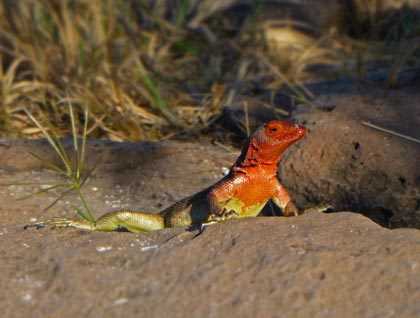Why is Espanola one of the most famous places in Galapagos? Well, it’s because the amount of wildlife found there. It is unbelievable! Everywhere - every step you take, a lizard, iguana, finch, sea gull, is around you. You have to walk with your five senses on alert. In Española you find endemic creatures not found anywhere else on this archipelago: albatrosses, colorful lava lizards and marine iguanas, and the very famous hood mockingbirds.
Indeed! This island is amazing and today we are here! We start our journey very early with some intrepid kayakers. At 6:30 a.m. they were out to explore the coastline of Gardner Bay. At 7:30 a.m. a nutritious breakfast was served, and then we went snorkeling. We found playful sea lions, sea stars, sea urchins, many schools of surgeon fish and king angel fish, and at the end we saw two juvenile black tip sharks. Wow, what a great morning! Then we walked on Garner Beach, recently considered one of the most beautiful places in the world, covered by tons of sea lions resting or just basking under the equatorial warm sun.
Our captain on the bridge was visited by some our junior travelers as we motored to Punta Suarez, home of the most majestic birds of the islands and one of the best gliders of the world. I am talking about the Galapagos waved albatross, the biggest bird found here and the heaviest as well. It weighs in at 16 pounds, a lot for a sea bird! Here it found nice flat areas to land and a great cliff to jump off. So we went to find these incredible birds, and we did!
At 3:30 p.m. we had a wet landing, the tide was super high and very unusual. We found many marine iguanas on the very black basaltic lava, while sea lions were playing along the coast. Further, a group of nazca and blue footed boobies were nesting on the ground or feeding, falling into the water to catch some fish. We found a couple of snakes, finches, warblers and some Galapagos doves digging seeds from the ground and below dry grass, the landscape looked arid and grey, with some evergreen plants that keep their color throughout the year. Currently, it’s the dry season in the islands, which means lack of food for land animals but plenty of food for marine creatures because of the cold water that the Humboldt Current brings here. The courtship of the albatrosses was fantastic; it is what our travelers love to see. It is so breathtaking to be there! Some of them were incubating a single egg they laid. Really it was a spectacular day, all of us are fascinated and astonished with the experience of exploring Española.
The afternoon became dark. The sun went down and now a piece of the moon appears in the sky. The Zodiacs move back on board. End of the journey, happy faces, mission accomplished. It was another great day in the enchanted islands.







